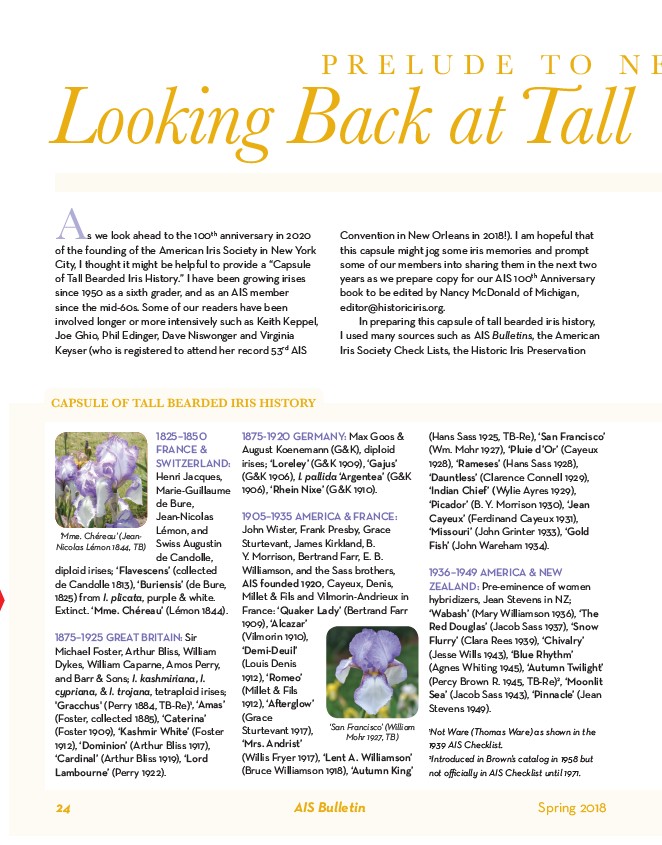
Looking Back P R E L U at D E Tall T O N E As we look ahead to the 100th anniversary in 2020
of the founding of the American Iris Society in New York
City, I thought it might be helpful to provide a “Capsule
of Tall Bearded Iris History.” I have been growing irises
since 1950 as a sixth grader, and as an AIS member
since the mid-60s. Some of our readers have been
involved longer or more intensively such as Keith Keppel,
Joe Ghio, Phil Edinger, Dave Niswonger and Virginia
Keyser (who is registered to attend her record 53rd AIS
Convention in New Orleans in 2018!). I am hopeful that
this capsule might jog some iris memories and prompt
some of our members into sharing them in the next two
years as we prepare copy for our AIS 100th Anniversary
book to be edited by Nancy McDonald of Michigan,
editor@historiciris.org.
In preparing this capsule of tall bearded iris history,
I used many sources such as AIS Bulletins, the American
Iris Society Check Lists, the Historic Iris Preservation
24 AIS Bulletin Spring 2018
CAPSULE OF TALL BEARDED IRIS HISTORY
1825–1850
FRANCE &
SWITZERLAND:
Henri Jacques,
Marie-Guillaume
de Bure,
Jean-Nicolas
Lémon, and
Swiss Augustin
de Candolle,
diploid irises; ‘Flavescens’ (collected
de Candolle 1813), ‘Buriensis’ (de Bure,
1825) from I. plicata, purple & white.
Extinct. ‘Mme. Chéreau’ (Lémon 1844).
1875–1925 GREAT BRITAIN: Sir
Michael Foster, Arthur Bliss, William
Dykes, William Caparne, Amos Perry,
and Barr & Sons; I. kashmiriana, I.
cypriana, & I. trojana, tetraploid irises;
'Gracchus' (Perry 1884, TB-Re)1, ‘Amas’
(Foster, collected 1885), ‘Caterina’
(Foster 1909), ‘Kashmir White’ (Foster
1912), ‘Dominion’ (Arthur Bliss 1917),
‘Cardinal’ (Arthur Bliss 1919), ‘Lord
Lambourne’ (Perry 1922).
1875-1920 GERMANY: Max Goos &
August Koenemann (G&K), diploid
irises; ‘Loreley’ (G&K 1909), ‘Gajus’
(G&K 1906), I. pallida ‘Argentea’ (G&K
1906), ‘Rhein Nixe’ (G&K 1910).
1905–1935 AMERICA & FRANCE:
John Wister, Frank Presby, Grace
Sturtevant, James Kirkland, B.
Y. Morrison, Bertrand Farr, E. B.
Williamson, and the Sass brothers,
AIS founded 1920, Cayeux, Denis,
Millet & Fils and Vilmorin-Andrieux in
France: ‘Quaker Lady’ (Bertrand Farr
1909), ‘Alcazar’
(Vilmorin 1910),
‘Demi-Deuil’
(Louis Denis
1912), ‘Romeo’
(Millet & Fils
1912), ‘Afterglow’
(Grace
Sturtevant 1917),
‘Mrs. Andrist’
(Willis Fryer 1917), ‘Lent A. Williamson’
(Bruce Williamson 1918), ‘Autumn King’
(Hans Sass 1925, TB-Re), ‘San Francisco’
(Wm. Mohr 1927), ‘Pluie d’Or’ (Cayeux
1928), ‘Rameses’ (Hans Sass 1928),
‘Dauntless’ (Clarence Connell 1929),
‘Indian Chief’ (Wylie Ayres 1929),
‘Picador’ (B. Y. Morrison 1930), ‘Jean
Cayeux’ (Ferdinand Cayeux 1931),
‘Missouri’ (John Grinter 1933), ‘Gold
Fish’ (John Wareham 1934).
1936–1949 AMERICA & NEW
ZEALAND: Pre-eminence of women
hybridizers, Jean Stevens in NZ;
‘Wabash’ (Mary Williamson 1936), ‘The
Red Douglas’ (Jacob Sass 1937), ‘Snow
Flurry’ (Clara Rees 1939), ‘Chivalry’
(Jesse Wills 1943), ‘Blue Rhythm’
(Agnes Whiting 1945), ‘Autumn Twilight’
(Percy Brown R. 1945, TB-Re)2, ‘Moonlit
Sea’ (Jacob Sass 1943), ‘Pinnacle’ (Jean
Stevens 1949).
1Not Ware (Thomas Ware) as shown in the
1939 AIS Checklist.
2Introduced in Brown’s catalog in 1958 but
not officially in AIS Checklist until 1971.
‘Mme. Chéreau’ (Jean-
Nicolas Lémon 1844, TB)
‘San Francisco’ (William
Mohr 1927, TB)